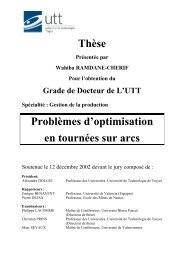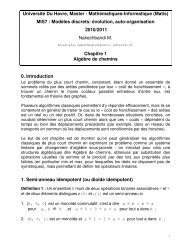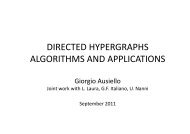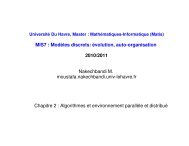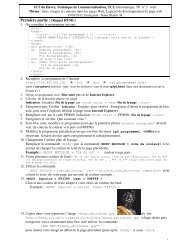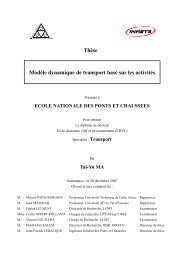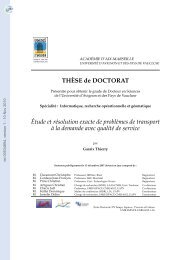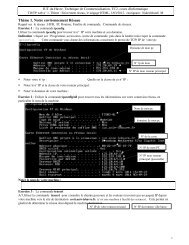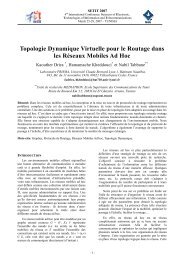Dynamic Graph Algorithms
Dynamic Graph Algorithms
Dynamic Graph Algorithms
You also want an ePaper? Increase the reach of your titles
YUMPU automatically turns print PDFs into web optimized ePapers that Google loves.
<strong>Dynamic</strong> <strong>Graph</strong> <strong>Algorithms</strong><br />
Giuseppe F. Italiano<br />
University of Rome “Tor Vergata”<br />
italiano@disp.uniroma2.it
Outline<br />
<strong>Dynamic</strong> <strong>Graph</strong> Problems<br />
Methodology & State of the Art<br />
Algorithmic Techniques & Experiments<br />
Conclusions
Outline<br />
<strong>Dynamic</strong> <strong>Graph</strong> Problems<br />
Methodology & State of the Art<br />
Algorithmic Techniques & Experiments<br />
Conclusions
Static <strong>Graph</strong>s…<br />
1736<br />
Paulus Ritius - Portae lucis, Augsburg, 1516.<br />
<strong>Graph</strong>s have been used for centuries<br />
to model relationships in life…<br />
A static life?
…or <strong>Dynamic</strong> <strong>Graph</strong>s?<br />
Sometimes, life<br />
looks a bit more<br />
dynamic …
<strong>Dynamic</strong> <strong>Graph</strong>s<br />
<strong>Graph</strong>s subject to update operations<br />
Typical updates:<br />
Insert(u,v)<br />
Delete(u,v)<br />
SetWeight(u,v,w)
<strong>Dynamic</strong> <strong>Graph</strong>s<br />
Initialize<br />
Insert<br />
Delete<br />
Query<br />
A graph<br />
n - number of vertices<br />
m - number of edges
<strong>Dynamic</strong> <strong>Graph</strong>s<br />
Partially dynamic problems<br />
<strong>Graph</strong>s subject to insertions only, or<br />
deletions only, but not both.<br />
Fully dynamic problems<br />
<strong>Graph</strong>s subject to intermixed sequences<br />
of insertions and deletions.
<strong>Dynamic</strong> <strong>Graph</strong> Problems<br />
Support query operations about<br />
certain property on a dynamic graph<br />
<strong>Dynamic</strong> Connectivity (undirected graph G)<br />
Connected(x,y):<br />
are x and y connected in G?<br />
<strong>Dynamic</strong> Transitive Closure (directed graph G)<br />
Reachable(x,y):<br />
is y reachable from x in G?
<strong>Dynamic</strong> <strong>Graph</strong> Problems<br />
<strong>Dynamic</strong> All Pairs Shortest Paths<br />
Distance(x,y):<br />
what is the distance from x to y in G?<br />
ShortestPath(x,y):<br />
what is the shortest path from x to y in G?<br />
<strong>Dynamic</strong> Minimum Spanning Tree<br />
(undirected graph G)<br />
any property on a MST of G
<strong>Dynamic</strong> <strong>Graph</strong> Problems<br />
<strong>Dynamic</strong> Min Cut<br />
Cut(x):<br />
what side of a global minimum<br />
cut of G vertex x belongs to?<br />
<strong>Dynamic</strong> Planarity Testing<br />
planar():<br />
is G planar?<br />
<strong>Dynamic</strong> k-connectivity<br />
k-connected():<br />
is G k-connected?
<strong>Dynamic</strong> <strong>Graph</strong> <strong>Algorithms</strong><br />
The goal of a dynamic graph algorithm is to<br />
support query and update operations as<br />
quickly as possible.<br />
We will sometimes use amortized bounds:<br />
Total worst-case time over sequence of ops<br />
Notation:<br />
# operations<br />
G = (V,E)<br />
n = |V|<br />
m = |E|
Fully <strong>Dynamic</strong> APSP<br />
Given a weighted directed graph G = (V,E,w),<br />
perform any intermixed sequence of the following<br />
operations:<br />
update cost of edge (u,v) to w<br />
Update(u,v,w): update edges incident to v [w( )]<br />
Update(v,w):<br />
Query(x,y):<br />
return distance from x to y<br />
(or shortest path from x to y)
Outline<br />
<strong>Dynamic</strong> <strong>Graph</strong> Problems<br />
Methodology & State of the Art<br />
Algorithmic Techniques & Experiments<br />
Conclusions
Methodology: Algorithm Engineering<br />
Theory<br />
In theory,<br />
theory and<br />
practice are<br />
the same.
Methodology: Algorithm Engineering<br />
The real world out there...<br />
In practice,<br />
theory and<br />
practice are<br />
different…
Programs are first class citizens as well<br />
Theory Practice<br />
Number types: N, R<br />
int, float, double<br />
Only asymptotics matter Seconds do matter<br />
Abstract algorithm<br />
description<br />
Unbounded memory,<br />
unit access cost<br />
Elementary operations take<br />
constant time<br />
Non-trivial implementation<br />
decisions, error-prone<br />
Memory hierarchy / bandwidth<br />
Instruction pipelining, …
Deeper<br />
insights<br />
The algorithm engineering cycle<br />
Bottlenecks,<br />
Heuristics<br />
Algorithm design<br />
Theoretical analysis<br />
Algorithm implementation<br />
Experimental analysis<br />
More<br />
realistic<br />
models<br />
Hints to<br />
refine<br />
analysis
Algorithm Engineering<br />
Source: www.algorithm-engineering.de
Few Success Stories<br />
New models of<br />
computation<br />
(Ladner et al, cacheaware<br />
analyses)<br />
Huge speedups in<br />
scientific applications<br />
(Anderson, Moret &<br />
Warnow, Arge et al.)<br />
New algorithms (Goldberg /<br />
Sanders / Wagner shortest paths)<br />
Bast, Funke, Sanders, & Schultes. Fast routing<br />
in road networks with transit nodes. Science,<br />
316:566, 2007.<br />
<strong>Algorithms</strong> and data<br />
structures for specific<br />
classes (Johnson et al,<br />
TSP; DIMACS<br />
Challenges)<br />
New conjectures,<br />
new theorems, new<br />
insights (Walsh &<br />
Gent Satisfiability,<br />
Bentley et al., Bin<br />
packing)<br />
Algorithmic Libraries<br />
(LEDA / CGAL,<br />
Mehlhorn et al….)
Further readings<br />
Algorithm engineering issues:<br />
Bernard Moret: “Towards a Discipline of Experimental<br />
Algorithmics”<br />
Richard Anderson: “The role of experiment in the theory<br />
of algorithms”<br />
David Johnson: “A theoretician's guide to the<br />
experimental analysis of algorithms”<br />
5th DIMACS Challenge Workshop:<br />
Experimental Methodology Day.<br />
Available at this page:<br />
http://www-users.cs.york.ac.uk/~tw/empirical.html
Outline<br />
<strong>Dynamic</strong> <strong>Graph</strong> Problems<br />
Methodology & State of the Art<br />
Algorithmic Techniques & Experiments<br />
Conclusions
Fully <strong>Dynamic</strong> APSP<br />
Given a weighted directed graph G = (V,E,w),<br />
perform any intermixed sequence of the following<br />
operations:<br />
update cost of edge (u,v) to w<br />
Update(u,v,w): update edges incident to v [w( )]<br />
Update(v,w):<br />
Query(x,y):<br />
return distance from x to y<br />
(or shortest path from x to y)
Simple-minded Approaches<br />
Fast query approach<br />
Keep the solution up to date.<br />
Rebuild it from<br />
scratch at each update.<br />
Fast update approach<br />
Do nothing on graph.<br />
Visit graph to<br />
answer queries.
<strong>Dynamic</strong> All-Pairs Shortest Paths<br />
Fast query approach<br />
Rebuild the distance matrix<br />
from scratch after each<br />
update.<br />
Query<br />
O(n 2 )<br />
O(1)<br />
O(1)<br />
Update<br />
O(n 3 )<br />
O(n 2 )<br />
O(1)<br />
O(1)<br />
Fast update approach<br />
To answer a query<br />
about (x,y), perform a<br />
single-source<br />
computation from x.<br />
Query<br />
Update
State of the Art<br />
First fully dynamic algorithms date back to the 60’s<br />
Until 1999, none of them was better in the worst case<br />
• P. Loubal, A network evaluation procedure, Highway<br />
than recomputing APSP from scratch (~ cubic time!)<br />
Research Record 205, 96-109, 1967.<br />
• J. Murchland, The effect of increasing or decreasing the<br />
<strong>Graph</strong> Weight<br />
Update<br />
length of a single arc on all shortest distances in a graph,<br />
Query<br />
Ramalin.&Reps 96 general real O(n 3) O(1)<br />
TR LBS-TNT-26, Transport Network Theory Unit,<br />
London Business School, 1967.<br />
King 99 general [0,C] O(n 2.5 (C log n) 0.5 ) O(1)<br />
• V. Rodionov, A dynamization of the all-pairs least cost<br />
• …<br />
problem, USSR Comput. Math. And Math. Phys. 8, 233-<br />
277, 1968.
Fully <strong>Dynamic</strong> APSP<br />
Edge insertions (edge cost decreases)<br />
Quite easy: O(n 2 )<br />
10<br />
x y<br />
i<br />
10<br />
10<br />
10<br />
For each pair x,y check whether<br />
D(x,i) + w(i,j) + D(j,y) < D(x,y)<br />
j
Fully <strong>Dynamic</strong> APSP<br />
• Edge deletions (edge cost increases)<br />
Seem the hard operations. Intuition:<br />
…<br />
G …<br />
0G<br />
• When edge (shortest path) deleted: need info<br />
about second shortest path? (3rd, 4th, …)
O(n 2 )<br />
O(1)<br />
<strong>Dynamic</strong> APSP<br />
Query<br />
O(1)<br />
Thorup, SWAT’04<br />
Supporting negative weights +<br />
improvements on log factors<br />
Demetrescu-I, J.ACM’04<br />
Real-weighted digraphs<br />
King, FOCS’99<br />
Unweighted digraphs<br />
O(n2 ) O(n3 O(n )<br />
2.5 ~ ~ ~<br />
)<br />
Update<br />
Decremental bounds: Baswana, Hariharan, Sen J.Algs’07<br />
Approximate dynamic APSP: Roditty, Zwick FOCS’04
Quadratic Update Time Barrier?<br />
Θ(n)<br />
+1<br />
-1<br />
+1<br />
If distances are to be maintained explicitly,<br />
any algorithm must pay Ω(n 2 ) per update…<br />
Θ(n)
Related Problems<br />
<strong>Dynamic</strong> Transitive Closure (directed graph G)<br />
update query authors<br />
notes<br />
O(n2 log n) O(1) King, FOCS’99<br />
O(n<br />
Demetrescu-I., Algorithmica’08<br />
1.575 ) O(n0.575 O(n DAGs<br />
) Demetrescu-I., J.ACM’05 DAGs<br />
Sankowski, FOCS’04<br />
2 ) O(1) King-Sagert, JCSS ‘02<br />
Roditty, ACM Tr. Algs.’08<br />
O(m n<br />
Decremental bounds: Baswana, Hariharan, Sen, J.Algs.’07<br />
1/2 ) O(n1/2 Sankowski, FOCS’04 worst-case<br />
) Roditty, Zwick, SIAM J. Comp.’08<br />
O(m+n log n) O(n) Roditty, Zwick, FOCS’04
Other Problems<br />
<strong>Dynamic</strong> Connectivity (undirected graph G)<br />
update query authors<br />
O(log 3 n) O(log n/log log n) Henzinger, King,<br />
J. ACM ‘99 (randomized)<br />
O(n 1/3 log n) O(1) Henzinger, King,<br />
SIAM J. Comp.’01<br />
O(log 2 n) O(log n/log log n) Holm, de Lichtenberg,<br />
Thorup, J.ACM’01<br />
Lower bounds:<br />
Ω(log n) update Patrascu & Demaine, SIAM J.Comp’06<br />
Ω((log n / log log n) 2 ) update Patrascu & Tarnita, TCS’07
Outline<br />
<strong>Dynamic</strong> <strong>Graph</strong> Problems<br />
Methodology & State of the Art<br />
Algorithmic Techniques & Experiments<br />
Conclusions
Algorithmic Techniques<br />
Will focus on techniques for path problems.<br />
Running examples: shortest paths/transitive closure
Main Ingredients<br />
Decremental BFS<br />
Path decompositions<br />
Locally-defined path properties<br />
Long paths property<br />
Counting<br />
Algebraic techniques<br />
Output bounded
<strong>Dynamic</strong> shortest paths: roadmap<br />
Reduced costs<br />
Shortest path<br />
trees<br />
Long paths<br />
decomposition<br />
Locally-defined<br />
path properties<br />
NSSSP<br />
Ramalingam-Reps ’96<br />
Decremental BFS<br />
Even-Shiloach ’81<br />
NAPSP/APSP<br />
Demetrescu-Italiano ‘04<br />
Thorup ‘05<br />
SSSP<br />
Frigioni et al ’98<br />
Demetrescu ’01<br />
NAPSP<br />
King ’99
Main Ingredients<br />
Decremental BFS<br />
Path decompositions<br />
Locally-defined path properties<br />
Long paths property<br />
Counting<br />
Algebraic techniques<br />
Output bounded
<strong>Dynamic</strong> shortest paths: roadmap<br />
Shortest path<br />
trees<br />
NSSSP<br />
Ramalingam-Reps ’96
Fully <strong>Dynamic</strong> SSSP<br />
Let:<br />
G = (V,E,w) weighted directed graph<br />
w(u,v) weight of edge (u,v)<br />
s ∈ V source node<br />
Perform intermixed sequence of operations:<br />
Increase(u,v,ε): Increase weight w(u,v) by ε<br />
Decrease(u,v,ε): Decrease weight w(u,v) by ε<br />
Query(v): Return distance (or sh. path)<br />
from s to v in G
Ramalingam & Reps’ approach<br />
Maintain a shortest paths tree throughout<br />
the sequence of updates<br />
Querying a shortest paths or distance takes<br />
optimal time<br />
Update operations work only on the portion of<br />
tree affected by the update<br />
Each update may take, in the worst case, as long<br />
as a static SSSP computation!<br />
But very efficient in practice
Increase(u,v,ε)<br />
T(s)<br />
s<br />
u<br />
+ε<br />
v<br />
Shortest paths<br />
tree before the update<br />
T(v)
Increase(u,v,ε)<br />
T'(s)<br />
w<br />
s<br />
+<br />
u<br />
+ε<br />
v<br />
T'(v)<br />
Shortest paths<br />
tree after the update
<strong>Graph</strong> G<br />
Ramalingam & Reps’ approach<br />
u<br />
s<br />
+ε<br />
v<br />
Subgraph induced by vertices in T(v)<br />
Perform SSSP<br />
only on the subgraph<br />
and source s<br />
s
Main Ingredients<br />
Decremental BFS<br />
Path decompositions<br />
Locally-defined path properties<br />
Long paths property<br />
Counting<br />
Algebraic techniques<br />
Output bounded
Path Counting [King/Sagert, JCSS’02]<br />
Maintain reachability information by keeping a count<br />
of the number of distinct paths in acyclic digraphs<br />
C[u,v]<br />
u C[u,x] x y C[y,v] v<br />
∀ u,v: C[u,v] ← C[u,v] + C[u,x] · C[y,v] O(n2 )<br />
Problem: counters as large as 2 n<br />
Solution: use arithmetic modulo a random prime…
<strong>Dynamic</strong> Transitive Closure [King/Sagert, JCSS’02]<br />
Update:<br />
Query:<br />
O(n 2 ) worst-case time<br />
O(1) worst-case time<br />
Works for acyclic digraphs.<br />
Randomized, one-sided error.<br />
Can we trade off query<br />
time for update time?
Looking from the matrix viewpoint<br />
C[u,v]<br />
u C[u,x] x y C[y,v] v<br />
∀ u,v:<br />
C[u,v] ← C[u,v] + C[u,x] · C[y,v]<br />
←<br />
+<br />
·
Maintaining dynamic integer matrices<br />
Given a matrix M of integers, perform any<br />
intermixed sequence of the following operations:<br />
Update(J,I): M ← M + J · I<br />
←<br />
Query(i,j): return M[i,j]<br />
+<br />
·<br />
O(n 2 )<br />
O(1)
Maintaining dynamic integer matrices<br />
How can we trade off operations?<br />
Lazy approach: buffer at most n ε updates<br />
Global reconstruction every n ε updates<br />
Reconstruction done via matrix multiplication
m<br />
Maintaining dynamic integer matrices<br />
+ j1 · i1 + j2· i2 + j3· i3 i2 I2 j 3<br />
J 3<br />
j 2<br />
J 2<br />
j 1<br />
J 1<br />
i 3<br />
i 1<br />
m<br />
I 3<br />
I 1<br />
M
Maintaining dynamic integer matrices<br />
m + j1 · i1+ j2· i2 + j3· i3 M’<br />
Global reconstruction every n ε updates<br />
m<br />
M<br />
+<br />
j 3<br />
J 3<br />
n ε<br />
j 2<br />
J 2<br />
j 1<br />
J 1<br />
·<br />
i 3<br />
i 2<br />
i 1<br />
O(n ω(1,ε,1) )<br />
n<br />
I 3<br />
I 2<br />
I 1
Back to <strong>Dynamic</strong> Transitive Closure<br />
C[u,v]<br />
u C[u,x] x y C[y,v] v<br />
∀ u,v:<br />
C[u,v] ← C[u,v] + C[u,x] · C[y,v]<br />
←<br />
+<br />
·
m<br />
Query Time<br />
+ j1 · i1+ j2 · i2 + j3 · i3 M’<br />
m<br />
M<br />
+<br />
Total Query time<br />
j 3<br />
J 3<br />
n ε<br />
j 2<br />
J 2<br />
j 1<br />
J 1<br />
·<br />
i 3<br />
i 2<br />
i 1<br />
O(n ε )<br />
n<br />
I 3<br />
I 2<br />
I 1
Update Time<br />
1. Compute C[u,x] and C[y,v] for any u,v<br />
Time:<br />
∀ u,v:<br />
C[u,v] ← C[u,v] + C[u,x] · C[y,v]<br />
O(n 1+ε )<br />
←<br />
Carried out via O(n) queries<br />
+<br />
·
Update Time<br />
2. Global rebuild every n ε updates<br />
M’<br />
m<br />
M<br />
Carried out via (rectangular) matrix multipl.<br />
Amortized time:<br />
+<br />
j 3<br />
J 3<br />
n ε<br />
j 2<br />
J 2<br />
j 1<br />
J 1<br />
·<br />
i 3<br />
i 2<br />
i 1<br />
O( n ω(1,ε,1) / n ε )<br />
n<br />
I 3<br />
I 2<br />
I 1
<strong>Dynamic</strong> Transitive Closure [Demetrescu-I., J.ACM05]<br />
O(nω(1,ε,1)-ε )<br />
O(nε Update: +n<br />
Query: )<br />
1+ε<br />
for any 0 < ε < 1<br />
Find ε such that ω(1,ε,1) = 1+2ε<br />
Best bound for rectangular matrix multiplication<br />
[Huang/Pan98]<br />
Update:<br />
Query:<br />
ε < 0.575<br />
O(n 1.575 ) worst-case time<br />
O(n 0.575 ) worst-case time
Main Ingredients<br />
Decremental BFS<br />
Path decompositions<br />
Locally-defined path properties<br />
Long paths property<br />
Counting<br />
Algebraic techniques<br />
Output bounded
<strong>Dynamic</strong> shortest paths: roadmap<br />
Reduced costs<br />
Shortest path<br />
trees<br />
NSSSP<br />
Ramalingam-Reps ’96<br />
Decremental BFS<br />
Even-Shiloach ’81<br />
SSSP<br />
Frigioni et al ’98<br />
Demetrescu ’01
depth d<br />
Decremental BFS [Even-Shiloach, JACM’81]<br />
Maintain BFS levels under deletion of edges<br />
Undirected graphs:<br />
non BFS-tree edges can be<br />
either between two<br />
consecutive levels<br />
or at the same level
Decremental BFS [Even-Shiloach, JACM’81]
depth d<br />
Decremental BFS [Even-Shiloach, JACM’81]<br />
This implies that during deletion of edges<br />
each non-tree edge can fall down<br />
at most 2d times overall…<br />
O(md) total time<br />
over any sequence<br />
O(d) time per deletion<br />
(amortized over<br />
Ω(m) deletions)
Can we do any better than O(mn)?<br />
Roditty and Zwick in ESA 2004 have shown<br />
two reductions:<br />
Boolean matrix<br />
multiplication<br />
Weighted (static)<br />
undirected APSP<br />
(off-line) decremental<br />
undirected BFS<br />
(off-line) decremental<br />
undirected SSSP
x<br />
Matrix mult. decremental BFS<br />
A<br />
Bipartite graph with<br />
an edge (x,y) for<br />
each A[x,y]=1<br />
B<br />
y<br />
Bipartite graph with<br />
an edge (x,y) for<br />
each B[x,y]=1<br />
A and B boolean matrices<br />
We wish to compute C=A·B<br />
C[x,y]=1 iff there is z such<br />
that A[x,z]=1 and B[z,y]=1<br />
C[x,y]=1 iff path of length 2<br />
between x on first layer and<br />
y on last layer
Matrix mult. decremental BFS<br />
A B<br />
s x 1 0 1 0 0<br />
x<br />
x<br />
First row: n deletions C[1,x]=1 and n iff dist(s,x)=3<br />
Second row: C[2,x]=1 iff dist(s,x)=4<br />
Third row: C[3,x]=1 iff dist(s,x)=5<br />
…<br />
…<br />
2 queries<br />
Decremental BFS in o(mn) total time would<br />
imply Boolean matrix multiplication in o(mn)<br />
C<br />
0 1 0 0 0<br />
0 0 0 0 0<br />
0 0 0 0 0<br />
1 0 1 0 0
More details in<br />
Decremental BFS:<br />
[Even-Shiloach’81]<br />
S. Even and Y. Shiloach,<br />
An On-line Edge Deletion Problem,<br />
J. Assoc. Comput. Mach, Vol. 28, pp. 1-4, 1981<br />
Reductions to decremental BFS:<br />
[Roditty-Zwick’04]<br />
Liam Roditty, Uri Zwick,<br />
On dynamic shortest paths problems<br />
Proc. of 12th ESA (2004), 580-591.
Main Ingredients<br />
Decremental BFS<br />
Path decompositions<br />
Locally-defined path properties<br />
Long paths property<br />
Counting<br />
Algebraic techniques<br />
Output bounded
<strong>Dynamic</strong> shortest paths: roadmap<br />
Reduced costs<br />
Shortest path<br />
trees<br />
Long paths<br />
decomposition<br />
NSSSP<br />
Ramalingam-Reps ’96<br />
Decremental BFS<br />
Even-Shiloach ’81<br />
SSSP<br />
Frigioni et al ’98<br />
Demetrescu ’01<br />
NAPSP<br />
King ’99
log n<br />
Doubling Decomposition [folklore]<br />
Transitive closure can be computed with O(log n)<br />
products of Boolean matrices<br />
X = adjacency matrix + I X n-1 = transitive closure<br />
X X<br />
X 2 X 2<br />
…<br />
X 4 X 4<br />
X n-1<br />
paths with ≤ 2 edges<br />
paths with ≤ 4 edges<br />
paths with ≤ 8 edges
<strong>Dynamic</strong> Transitive Closure [King, FOCS’99]<br />
Ingredients:<br />
IN(v) maintained as a decremental BFS tree<br />
d=2<br />
d=2<br />
Decremental BFS<br />
x<br />
v<br />
y<br />
Doubling decomposition<br />
Building block:<br />
pair of IN/OUT trees<br />
keeps track of all paths of<br />
length ≤ 4 2 passing through v<br />
OUT(v) maintained as a decremental BFS tree<br />
Total cost for building the two trees + deleting all edges: O(m)<br />
+
<strong>Dynamic</strong> Transitive Closure [King, FOCS’99]<br />
G 0 = G<br />
G 1<br />
G 2<br />
G 3<br />
… … … … … … …<br />
G log n<br />
IN/OUT trees in G 0 for each vertex<br />
IN/OUT trees in G 1 for each vertex<br />
(x,y) ∈ G1 iff<br />
x ∈ IN(v) and<br />
y ∈ OUT(v) for<br />
some v in G0 (x,y) ∈ G2 iff<br />
x Invariant: ∈ IN(v) and<br />
y ∈ OUT(v) for<br />
If there is a path<br />
some v in G1 from x to y in G<br />
of length k, then<br />
there is an edge<br />
(x,y) in G⎡log k⎤<br />
Reachability<br />
queries in G ⎡log n⎤
<strong>Dynamic</strong> Transitive Closure [King, FOCS’99]<br />
G 0 = G<br />
G 1<br />
G 2<br />
G 3<br />
…<br />
G log n<br />
Deletion of any subset of the edges of G<br />
… … … … … …<br />
Edge<br />
deletions<br />
(cost charged<br />
to the creation<br />
of the trees)
<strong>Dynamic</strong> Transitive Closure [King, FOCS’99]<br />
G 0 = G<br />
G 1<br />
G 2<br />
G 3<br />
…<br />
G log n<br />
Insertion of edges incident to a vertex v<br />
v<br />
v<br />
vv<br />
… … …<br />
… … …<br />
vv<br />
IN(v) and<br />
OUT(v)<br />
rebuilt from<br />
scratch on<br />
each level…<br />
O(n 2 log n)<br />
time
<strong>Dynamic</strong> Transitive Closure [King, FOCS’99]<br />
G 0 = G<br />
G 1<br />
G 2<br />
G 3<br />
…<br />
G log n<br />
Insertion of edges incident to a vertex v<br />
v<br />
v<br />
v<br />
… … …<br />
… … …<br />
v<br />
Correctness?<br />
Path a,b,c in G i-1<br />
⇒ (a,c) in G i ?<br />
a<br />
b<br />
c
Main Ingredients<br />
Decremental BFS<br />
Path decompositions<br />
Locally-defined path properties<br />
Long paths property<br />
Counting<br />
Algebraic techniques<br />
Output bounded
A real-life problem<br />
“Road”
Highway<br />
entry<br />
points<br />
Road<br />
A real-life problem<br />
Highway<br />
Road<br />
“Road”
Are there roads and highways in graphs?<br />
Long Paths Property [Greene-Knuth ‘82]<br />
Let P be a path of length at least k.<br />
Let S be a random subset of vertices<br />
of size (c n ln n) / k.<br />
Then with high probability P ∩ S ≠≠≠≠ ∅∅∅∅.<br />
Probability p ≥ 1 – 1 / n c
Long Paths Property [Greene-Knuth ‘82]<br />
Select each element<br />
independently with probability<br />
k<br />
The probability that a<br />
given set of k elements<br />
is not hit is<br />
n<br />
p<br />
(1 − p)<br />
k<br />
=<br />
c ln n<br />
k<br />
⎛ c ln n ⎞<br />
= ⎜1− ⎟ < n<br />
⎝ k ⎠<br />
k<br />
−c
Long Paths Property [Greene-Knuth ‘82]<br />
Let P be a path of length at least k.<br />
Let S be a random subset of vertices of size<br />
(c n ln n) / k.<br />
Then with high probability there is no<br />
subpath of P of length k with no vertices in<br />
S (P ∩ S ≠≠≠≠ ∅∅∅∅ ).<br />
Probability p ≥ 1 – 1 / n α( α(c) for some α > 0.
Long Paths Property<br />
Randomly pick a set S of vertices in the graph<br />
|S| =<br />
c n log n<br />
k<br />
c, k > 0<br />
Then on any path in the graph<br />
every k vertices there is a vertex in S,<br />
with probability p ≥ 1 – 1 / nα( α( α( α(c)<br />
Roads and Highways in <strong>Graph</strong>s<br />
Highway entry points = vertices in S<br />
Road = shortest path using at most k edges<br />
Highway = shortest path between two vertices in S<br />
Highway<br />
1<br />
Computing Shortest Paths 1/3<br />
k<br />
Compute roads<br />
(shortest paths using at most k edges)<br />
Roma Erice<br />
Even & Shiloach BFS trees may become handy…
2<br />
Computing Shortest Paths 2/3<br />
3<br />
Computing Shortest Paths 3/3<br />
Compute shortest paths (longer than k edges)<br />
(by stitching together roads + highways + roads)<br />
Highway<br />
Roma Erice<br />
Road Road<br />
Used (for dynamic graphs) by King [FOCS’99],<br />
Demetrescu-I. [JCSS’06], Roditty-Zwick [FOCS’04], …
Fully <strong>Dynamic</strong> APSP<br />
Given a weighted directed graph G=(V,E,w),<br />
perform any intermixed sequence of the following<br />
operations:<br />
Update(u,v,w):<br />
Query(x,y):<br />
update weight of edge (u,v) to w<br />
return distance from x to y<br />
(or shortest path from x to y)
King’s algorithm [King’99]<br />
Directed graphs with integer edge weights in [0,C]<br />
O(1) query time O(n2.5 O(n √C) space<br />
2.5 ~ ~<br />
√C) update time<br />
Approach:<br />
1. Maintain dynamically shortest paths up to length<br />
k=(nC) 0.5 using variant of decremental data<br />
structure by Even-Shiloach<br />
2. Stitch together short paths from scratch to form<br />
long paths exploiting long paths decomposition<br />
More details in<br />
Long paths decomposition:<br />
[Ullman-Yannakakis’91]<br />
J.D. Ullman and M. Yannakakis.<br />
High-probability parallel transitive-closure algorithms.<br />
SIAM Journal on Computing, 20(1), February 1991<br />
King’s algorithm:<br />
[King’99]<br />
Valerie King<br />
Fully <strong>Dynamic</strong> <strong>Algorithms</strong> for Maintaining All-Pairs<br />
Shortest Paths and Transitive Closure in Digraphs.<br />
FOCS 1999: 81-91
Main Ingredients<br />
Decremental BFS<br />
Path decompositions<br />
Locally-defined path properties<br />
Long paths property<br />
Counting<br />
Algebraic techniques<br />
Output bounded
<strong>Dynamic</strong> shortest paths: roadmap<br />
Reduced costs<br />
Shortest path<br />
trees<br />
Long paths<br />
decomposition<br />
Locally-defined<br />
path properties<br />
NSSSP<br />
Ramalingam-Reps ’96<br />
Decremental BFS<br />
Even-Shiloach ’81<br />
NAPSP/APSP<br />
Demetrescu-Italiano ‘04<br />
Thorup ‘05<br />
SSSP<br />
Frigioni et al ’98<br />
Demetrescu ’01<br />
NAPSP<br />
King ’99
1.<br />
Using LSP’s to speed up Dijkstra (NAPSP)<br />
Dijkstra’s algorithm for NAPSP<br />
Run Dijkstra from all vertices “in parallel”<br />
Edge scanning bottleneck for dense graphs [Goldberg]<br />
1.<br />
Extract shortest pair (x,y) from heap:<br />
y’ 2. Scan all<br />
neighbors<br />
x y y’ of y<br />
3. Possibly insert (x,y’) into heap or decrease its priority<br />
Can we do better?<br />
Extract shortest pair (x,y) from heap:<br />
x a<br />
y<br />
3. Possibly insert (x,y’) into heap or decrease priority<br />
y’<br />
2. Scan only<br />
y’ for which<br />
(a,y’) shortest<br />
(subpath opt.)
Locally Shortest Paths [Demetrescu-I., J.ACM04]<br />
LOCALLY<br />
SHORTEST<br />
NOT<br />
LOCALLY<br />
SHORTEST<br />
A path is locally shortest if all of its<br />
proper subpaths are shortest paths<br />
π xy<br />
π xy<br />
x y<br />
Shortest path Shortest path<br />
Not a shortest path<br />
Shortest path<br />
x y
Locally shortest paths<br />
By optimal-substructure property<br />
of shortest paths:<br />
Shortest paths<br />
Locally<br />
shortest paths
How much do we gain?<br />
Running time on directed graphs<br />
with real non-negative edge weights<br />
O( #LS-paths + n 2 log n) time<br />
O(n 2 ) space<br />
Q.: How many locally shortest paths ?<br />
A.: #LS-paths ≤ mn. No gain in<br />
asymptopia…<br />
Q.: How much can we gain in practice?
25,000,000<br />
20,000,000<br />
15,000,000<br />
10,000,000<br />
5,000,000<br />
0<br />
How many LSP’s in a graph?<br />
Locally shortest paths in random graphs (500 nodes)<br />
m*n<br />
#LS-paths<br />
n*n<br />
0 5000 10000 15000 20000 25000 30000 35000 40000 45000 50000<br />
# edges<br />
m*n<br />
#LS-paths<br />
n*n
Real-world <strong>Graph</strong>s?
3.5<br />
3.0<br />
2.5<br />
2.0<br />
1.5<br />
1.0<br />
0.5<br />
0.0<br />
US road networks<br />
average degree<br />
#LS-paths per pair<br />
Locally shortest paths in US road networks<br />
DE NV NH ME AZ ID MT ND CT NM MA NJ LA CO MD NE MS IN AR KS KY MI IA AL MN MO CA NC<br />
US states
18<br />
16<br />
14<br />
12<br />
10<br />
8<br />
6<br />
4<br />
2<br />
0<br />
Can we exploit this in practice?<br />
Experiment for increasing number of edges (rnd, 500 nodes)<br />
Dijkstra<br />
New algorithm<br />
0 5000 10000 15000 20000 25000 30000 35000 40000 45000 50000<br />
Number of edges<br />
Dijkstra's<br />
algorithm<br />
Algorithm based<br />
on locally shortest paths
Deeper<br />
insights<br />
What we have seen so far:<br />
Bottlenecks,<br />
Heuristics<br />
Algorithm design<br />
Theoretical analysis<br />
Algorithm implementation<br />
Experimental analysis<br />
More<br />
realistic<br />
models<br />
Hints to<br />
refine<br />
analysis
Deeper<br />
insights<br />
Return Trip to Theory:<br />
Bottlenecks,<br />
Heuristics<br />
Algorithm design<br />
Theoretical analysis<br />
Algorithm implementation<br />
Experimental analysis<br />
More<br />
realistic<br />
models<br />
Hints to<br />
refine<br />
analysis
Back to Fully <strong>Dynamic</strong> APSP<br />
Given a weighted directed graph G=(V,E,w),<br />
perform any intermixed sequence of the following<br />
operations:<br />
Update(u,v,w):<br />
Query(x,y):<br />
update cost of edge (u,v) to w<br />
return distance from x to y<br />
(or shortest path from x to y)
Recall Fully <strong>Dynamic</strong> APSP<br />
• Hard operations seem edge deletions<br />
(edge cost increases)<br />
• When edge (shortest path) deleted: need info<br />
about second shortest path? (3rd, 4th, …)<br />
• Hey… what about locally shortest paths?<br />
π xy<br />
x y<br />
Shortest Locally path shortest Shortest path<br />
path<br />
Candidate for being shortest path?
Locally Shortest Paths for <strong>Dynamic</strong> APSP<br />
Idea:<br />
Maintain all the locally shortest<br />
paths of the graph<br />
How do locally shortest paths<br />
change in a dynamic graph?
Assumptions behind the analysis<br />
Property 1<br />
Locally shortest paths π xy are internally vertex-disjoint<br />
π 1<br />
π 2<br />
x y<br />
π 3<br />
This holds under the assumption that there is a unique<br />
shortest path between each pair of vertices in the graph<br />
(Ties can be broken by adding a small perturbation to<br />
the weight of each edge)
Tie Breaking<br />
Assumptions<br />
Shortest paths are unique<br />
In theory, tie breaking is not a problem<br />
Practice<br />
In practice, tie breaking can be subtle
Properties of locally shortest paths<br />
Property 2<br />
There can be at most n-1 LS paths connecting x,y<br />
x y<br />
This is a<br />
consequence of<br />
vertexdisjointess…
Appearing locally shortest paths<br />
Fact 1<br />
At most mn (n 3 ) paths can start being locally<br />
shortest after an edge weight increase<br />
10<br />
20<br />
x y<br />
100<br />
30<br />
40
Disappearing locally shortest paths<br />
Fact 2<br />
At most n 2 paths can stop being locally shortest<br />
after an edge weight increase<br />
π stops being locally shortest after increase of e<br />
subpath of π (was shortest path) must contain e<br />
shortest paths are unique: at most n 2 contain e
Maintaining locally shortest paths<br />
# Locally shortest paths appearing after increase: < n 3<br />
# Locally shortest paths disappearing after increase: < n 2<br />
The amortized number of changes in the set of<br />
locally shortest paths at each update in an<br />
increase-only sequence is O(n 2 )
An increase-only update algorithm<br />
This gives (almost) immediately:<br />
O(n 2 log n) amortized time per increase<br />
O(mn) space
Maintaining locally shortest paths<br />
What about fully dynamic sequences?<br />
10<br />
20<br />
x y<br />
100<br />
30<br />
40
How to pay only once?<br />
x y<br />
This path remains the same while flipping<br />
between being LS and non-LS:<br />
Would like to have update algorithm<br />
that pays only once for it<br />
until it is further updated...
Looking at the substructure<br />
x y<br />
This This path isremains no longer a shortest a shortest path path<br />
after the after insertion the insertion…<br />
It is not<br />
dead!<br />
…but if we removed the same edge<br />
it would be a shortest path again!
Historical paths<br />
A path is historical if it was shortest<br />
at some time since it was last updated<br />
historical path<br />
x y
Locally historical paths<br />
Locally shortest<br />
path<br />
Locally historical<br />
path<br />
π xy<br />
π xy<br />
x<br />
x<br />
Shortest path<br />
Shortest path<br />
Historical path<br />
Historical path<br />
y<br />
y
Key idea for partially dynamic<br />
SP<br />
LSP
Key idea for fully dynamic<br />
HP<br />
SP<br />
LHP
Putting things into perspective…<br />
HP<br />
SP<br />
LHP<br />
LSP
The fully dynamic update algorithm<br />
Idea:<br />
Maintain all the locally historical paths<br />
of the graph<br />
Fully dynamic update algorithm very similar to<br />
partially dynamic, but maintains locally<br />
historical paths instead of locally shortest paths<br />
(+ performs some other operations)<br />
O(n 2 log 3 n) amortized time per update<br />
O(mn log n) space
More details in<br />
Locally shortest paths:<br />
[Demetrescu-Italiano’04]<br />
C. Demetrescu and G.F. Italiano<br />
A New Approach to <strong>Dynamic</strong> All Pairs Shortest Paths<br />
Journal of the Association for Computing Machinery<br />
(JACM), 51(6), pp. 968-992, November 2004<br />
Dijkstra’s variant based on locally shortest paths:<br />
[Demetrescu-Italiano’06]<br />
Camil Demetrescu, Giuseppe F. Italiano: Experimental<br />
analysis of dynamic all pairs shortest path algorithms.<br />
ACM Transactions on <strong>Algorithms</strong> 2 (4): 578-601 (2006).
<strong>Dynamic</strong> shortest paths: roadmap<br />
Reduced costs<br />
Shortest path<br />
trees<br />
Long paths<br />
decomposition<br />
Locally-defined<br />
path properties<br />
NSSSP<br />
Ramalingam-Reps ’96<br />
Decremental BFS<br />
Even-Shiloach ’81<br />
NAPSP/APSP<br />
Demetrescu-Italiano ‘04<br />
Thorup ‘05<br />
SSSP<br />
Frigioni et al ’98<br />
Demetrescu ’01<br />
NAPSP<br />
King ’99<br />
Experimental<br />
comparison
A comparative experimental analysis<br />
(<strong>Dynamic</strong>) NAPSP algorithms under investigation<br />
Name Weight<br />
Update<br />
Query<br />
Dijkstra 59 (FT 87) S-DIJ real O(mn + n 2 log n) O(1)<br />
Demetrescu/I. 06 S-LSP real O(#LSP + n 2 log n) O(1)<br />
Ramaling./Reps 96<br />
(SIMPLE) D-RRL real O(mn + n 2 log n) O(1)<br />
King 99 D-KIN [0,C] O(n2.5 (C log n) 0.5 ) O(1)<br />
Demetrescu/I. 04 D-LHP real O(n2) ~<br />
O(1)
Experimental setup<br />
Test sets<br />
Hardware<br />
Random (strongly connected)<br />
US road maps (n = hundreds to thousands)<br />
AS Internet subgraphs (thousands of nodes)<br />
Pathological instances<br />
Random updates / pathological updates<br />
Athlon 1.8 GHz - 256KB cache L2 - 512MB RAM<br />
Pentium IV 2.2GHz - 512KB cache L2 - 2GB RAM<br />
PowerPC G4 500MHz - 1MB cache L2 - 384MB RAM<br />
IBM Power 4 - 32MB cache L3 - 64GB RAM
Experimental setup<br />
Operating systems<br />
Linux<br />
Solaris<br />
Windows 2000/XP<br />
Mac OS X<br />
Compilers & Analysis Tools<br />
gcc (GNU)<br />
xlc (Intel compiler)<br />
Microsoft Visual Studio<br />
Metrowerks CodeWarrior<br />
Valgrind<br />
(monitor memory usage)<br />
Cachegrind<br />
(cache misses)
Implementation issues<br />
For very sparse graphs, heap operations are crucial,<br />
so good data structures (buckets, smart queues, etc.)<br />
make difference…<br />
In our experiments, we were mainly interested in edge<br />
scans for different graph densities<br />
Not the best possible implementations (some library<br />
overhead): we look for big (> 2x) relative performance<br />
ratios<br />
A lot of tuning: we tried to find a good setup of<br />
relevant parameters for each implementation
Algorithm D-RRL [Demetr.’01]<br />
Directed graphs with real edge weights<br />
O(mn+n 2 log n) update time<br />
Approach:<br />
Maintain n shortest path trees<br />
Work on each tree after each update<br />
Run Dijkstra variant only on nodes<br />
of the affected subtree<br />
(SIMPLE algorithm described<br />
earlier)<br />
O(1) query time O(n 2 ) space<br />
T(s)<br />
w<br />
s<br />
+<br />
u<br />
+ε<br />
v<br />
T(v)
Algorithm D-KIN [King’99]<br />
Directed graphs with integer edge weights in [0,C]<br />
O(1) query time O(n2.5 O(n √C) space<br />
2.5 ~ ~<br />
√C) update time<br />
Approach:<br />
1. Maintain dynamically shortest paths up to length<br />
k=(nC) 0.5 using variant of decremental data<br />
structure by Even-Shiloach<br />
2. Stitch together short paths from scratch to form<br />
long paths exploiting long paths decomposition<br />
Algorithm D-LHP [Dem.-Italiano’03]<br />
O(n O(1) time per query<br />
2 Directed graphs with real edge weights<br />
~<br />
) time per update<br />
~<br />
O(mn) space<br />
Approach:<br />
Maintain locally historical paths (LHP):<br />
paths whose proper subpaths have been shortest paths…<br />
Shortest paths<br />
Locally<br />
shortest paths<br />
Locally<br />
historical paths
0.025<br />
0.02<br />
0.015<br />
0.01<br />
0.005<br />
0<br />
Are LHPs useful in practice? (update time)<br />
Experiment for increasing # of edges (rnd, 500 nodes)<br />
0 5000 10000 15000 20000 25000 30000 35000 40000 45000 50000<br />
Number of edges<br />
D-RRL<br />
D-LHP<br />
D-RRL<br />
D-LHP
0.035<br />
0.03<br />
0.025<br />
0.02<br />
0.015<br />
0.01<br />
0.005<br />
0<br />
What about real graphs? (update time)<br />
D-RRL<br />
D-LHP<br />
Experiments on US road networks<br />
HI DE NV NH ME ID MT ND CT NM MA NJ LA CO MD NE MS IN AR KS KY MI IA AL MN MO CA NC<br />
US states
2<br />
1.8<br />
1.6<br />
1.4<br />
1.2<br />
1<br />
0.8<br />
0.6<br />
0.4<br />
0.2<br />
0<br />
Zoom out to static (update time)<br />
S-DIJ<br />
D-RRL<br />
D-LHP<br />
Experiments on US road networks<br />
HI DE NV NH ME AZ ID MT ND CT NM MA NJ LA CO MD NE MS IN AR KS KY MI IA AL MN MO CA NC<br />
US states
140<br />
120<br />
100<br />
80<br />
60<br />
40<br />
20<br />
0<br />
Big issue: hit the space wall<br />
Experiments on US road networks<br />
0 200 400 600 800 1000<br />
# nodes
Relative time performance D-RLL/D-LHP<br />
2.4<br />
2.2<br />
2.0<br />
1.8<br />
1.6<br />
1.4<br />
1.2<br />
1.0<br />
0.8<br />
0.6<br />
0.4<br />
DE<br />
Experiments on US road networks<br />
NV<br />
NH<br />
AZ<br />
ME<br />
MT<br />
ID<br />
D-LHP slower than D-RRL<br />
(on different platforms)<br />
CT<br />
ND<br />
NM<br />
MA<br />
NJ<br />
CO<br />
LA<br />
MD<br />
NE<br />
MS<br />
IBM Power 4<br />
Sun UltraSPARC IIi<br />
AMD Athlon<br />
1 2 3 4 5 6 7 8 9 10<br />
AR<br />
IN<br />
KS<br />
Number of edges (x 100)<br />
KY<br />
MI<br />
IA<br />
D-LHP faster than D-RRL<br />
(32MB L3 cache)<br />
(2MB L2 cache)<br />
(256KB L2 cache)<br />
MN<br />
AL<br />
MO<br />
IBM Power 4<br />
Sun UltraSPARC IIi<br />
AMD Athlon<br />
CA<br />
NC<br />
OH
2.0<br />
1.8<br />
1.6<br />
1.4<br />
1.2<br />
1.0<br />
0.8<br />
0.6<br />
0.69<br />
Cache effects<br />
Simulated cache miss ratio D-RRL/D-LHP<br />
Performance ratio D-RRL/D-LHP on real architectures<br />
Athlon<br />
0.75<br />
0.71<br />
Xeon<br />
0.87<br />
0.84<br />
Colorado road network<br />
1.00<br />
1.17<br />
0.92<br />
UltraSPARC IIi<br />
128KB 256KB 512KB 1MB 2MB 4MB 8MB 16MB 32MB<br />
Cache size<br />
1.30<br />
1.41<br />
1.83<br />
11.12<br />
Power 4<br />
1.59
Time per update (sec)<br />
100<br />
10<br />
1<br />
0,1<br />
0,01<br />
The big picture (update time)<br />
Experiment for increasing # of edges (rnd, 500 nodes, w=1..5)<br />
0,001<br />
0 5000 10000 15000 20000 25000 30000 35000 40000 45000 50000<br />
Number of edges<br />
S-DIJ<br />
D-LHP<br />
D-KIN<br />
D-RRL<br />
S-LSP<br />
S-DIJ<br />
S-LSP<br />
D-KIN<br />
D-RRL<br />
D-LHP
2<br />
1.8<br />
1.6<br />
1.4<br />
1.2<br />
1<br />
0.8<br />
0.6<br />
0.4<br />
0.2<br />
0<br />
What about pathological instances?<br />
Experiments on bottleneck graphs (500 nodes, IBM Power4)<br />
updates<br />
0 5000 10000 15000 20000 25000 30000 35000<br />
# edges<br />
D-RRL<br />
S-DIJ<br />
D-LHP<br />
S-LSP
What did we learn for sparse graphs?<br />
Best that one could hope for (in practice):<br />
Small data structure overhead<br />
Work only on the affected shortest paths<br />
D-RRL (Dem.’01 implem. Ram-Reps approach):<br />
Very simple Hard to beat!<br />
(but quite bad on<br />
pathological instances)<br />
D-LHP (Dem-Ita’04):<br />
Can be as efficient as D-RLL (best with good<br />
memory hierarchy: cache, memory bandwidth)<br />
D-KIN (King’99):<br />
Overhead in stitching and data structure operations
What did we learn for dense graphs?<br />
Locally shortest/historical paths can be very useful<br />
<strong>Dynamic</strong> algorithm D-LHP is the fastest in practice<br />
on all the test sets and platforms we considered<br />
New static algorithm S-LSP can beat S-DIJ by a<br />
factor of 10x in practice on dense graphs
Concluding remarks<br />
#locally shortest paths ≈ #shortest paths<br />
in all the graphs we considered (real/synthetic)<br />
Careful implementations might fully exploit this<br />
(by keeping data structure overhead<br />
as small as possible)<br />
Space wall! Time kills you slowly, but space can kill<br />
you right away…<br />
With 3000 vertices, 80 bytes per vertex pair:<br />
quadratic space means 720 Mbytes<br />
With RAMs order of GB, that’s about it!
More details in<br />
Algorithm D-LHP:<br />
[Demetrescu-Italiano’04]<br />
C. Demetrescu and G.F. Italiano<br />
A New Approach to <strong>Dynamic</strong> All Pairs Shortest Paths<br />
Journal of the Association for Computing Machinery<br />
(JACM), 51(6), pp. 968-992, November 2004<br />
Computational study of dynamic NAPSP algorithms:<br />
[Demetrescu-Italiano’06]<br />
C. Demetrescu, G. F. Italiano: Experimental analysis of<br />
dynamic all pairs shortest path algorithms. ACM<br />
Transactions on <strong>Algorithms</strong> 2 (4): 578-601 (2006).
Further Improvements [Thorup, SWAT’04]<br />
Using locally historical paths,<br />
Thorup has shown:<br />
O(n 2 (log n + log 2 (m/n)))<br />
amortized time per update<br />
O(mn) space
Outline<br />
<strong>Dynamic</strong> <strong>Graph</strong> Problems<br />
Methodology & State of the Art<br />
Algorithmic Techniques<br />
Conclusions
More Work to do on <strong>Dynamic</strong> APSP<br />
Space is a BIG issue in practice<br />
More tradeoffs for dynamic shortest paths?<br />
Roditty-Zwick, ESA 04 O(mn1/2 ) update, O(n3/4 ~<br />
) query<br />
for unweighted<br />
Worst-case bounds?<br />
Thorup, STOC 05 O(n2.75 ~<br />
) update<br />
Lower bounds?
Some Open Problems…<br />
Fully <strong>Dynamic</strong> Single-Source Shortest Path<br />
Nothing better than simple-minded approaches<br />
General Techniques for making increase-only<br />
fully dynamic?<br />
Fully exploited on dynamic undirected graphs
Some Open Problems…<br />
<strong>Dynamic</strong> Maximum st-Flow<br />
Flow(x,y):<br />
what is the flow assigned to edge (x,y)<br />
in a maximum st-flow in G?<br />
<strong>Dynamic</strong> Diameter<br />
Diameter():<br />
what is the diameter of G?
Some Open Problems…<br />
<strong>Dynamic</strong> Strongly Connected Components<br />
(directed graph G)<br />
SCC(x):<br />
what is the representative vertex in<br />
the SCC of G that contains x?<br />
Static Problem: Strong Articulation Points<br />
(directed graph G)<br />
SAP(x):<br />
is the removal of vertex x disconnect<br />
the SCC of G that contains x?


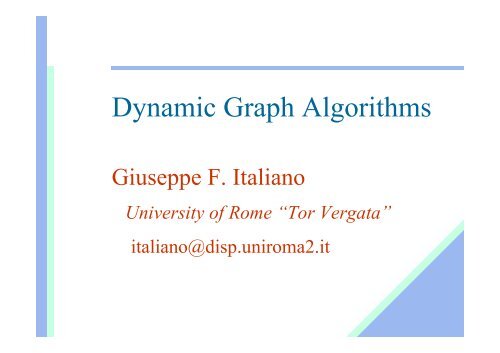
![[tel-00371962, v1] Modélisation et traitement décentralisé ... - Index of](https://img.yumpu.com/19037996/1/184x260/tel-00371962-v1-modelisation-et-traitement-decentralise-index-of.jpg?quality=85)
